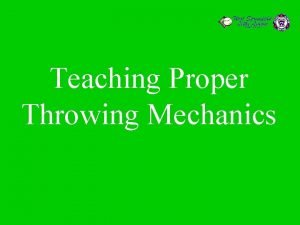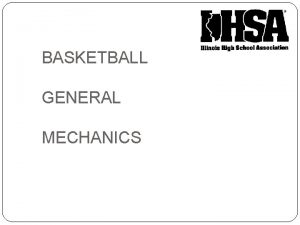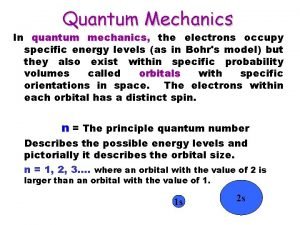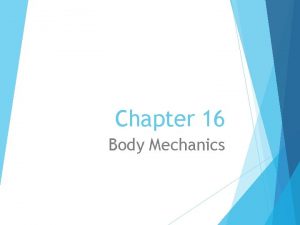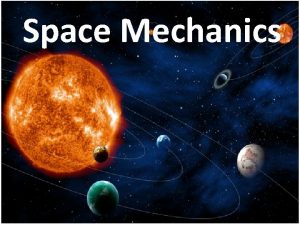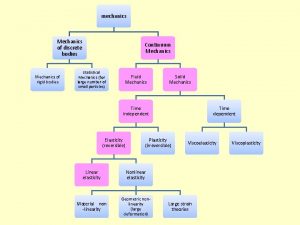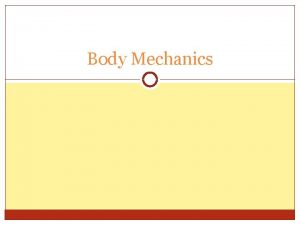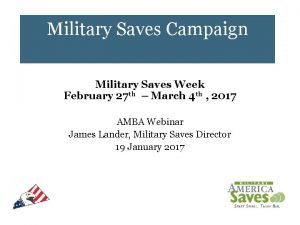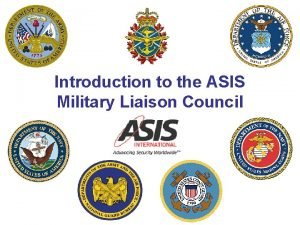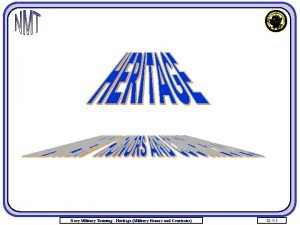The Mechanics of Teaching Mechanics Experiences Teaching Military





















- Slides: 21

The Mechanics of Teaching Mechanics: Experiences Teaching Military Aircraft Technicians with Limited English Language Knowledge Dugald Sturges, Bundessprachenamt, Hürth, Germany

English for Naval Aviation Technicians Course objective: To develop English language skills in order to prepare naval aviation technical staff for training on the Lockheed P 3 -Orion. Skills enabling: - To enable the participants to discuss technical matters with foreign colleagues in English. - To enable them to read and understand Englishlanguage technical documentation, with particular emphasis on the P 3 -Orion technical manual. - To refresh and improve their knowledge of general English in order to improve their communicative competence in an English-speaking environment.



ASD Simplified Technical English (ASD-STE 100) • One word - one meaning • Sentence length of no more than 25 words. • Paragraph length of no more than 6 sentences. • Noun cluster length of 3 words or less. • Avoiding missing articles • Unapproved verbal auxiliaries (passive, progressive, perfect, modals). • Unapproved -ing participles. • Only one command per sentence.

BEFORE - Original text: Three phase power is provided by three separate generators. They are the main source of power for the main ac buses and the whole electrical power system. Two generators are driven by the engines and one generator is driven by the auxiliary power unit (APU). AFTER - Text rewritten in ASD Simplified Technical English: Three generators supply 3 -phase electrical power. These generators are the primary source of power for the primary AC buses and the electrical power system. The engines operate two of the generators. The auxiliary power unit (APU) operates one generator. (source: http: //www. simplifiedenglish. net/en/ste/)

REALITY Forty-six service outlets are provided throughout the aircraft to supply power for electronic/electrical maintenance equipment and for small appliance use. All outlets are energized whenever power is supplied to the aircraft electrical system. All AC outlets are 400 cycle. Six 2 -prong, 28 VDC service outlets, located at the pilot, copilot, TACCO, NAV/COMM, port aft observer, and starboard aft observer stations are provided. Four additional outlets supply 115 VAC power to four-pin receptacles for the pilot, copilot, port aft observer, and starboard aft observer. Phase A, 115 VAC is supplied to twenty outlets throughout the aircraft including one 4 pin receptacle located in the forward radar rack to test the T-414 AMAC control box. The remaining outlets are 3 -prong. In addition, eleven 3 -prong outlets supply phase B alternating current. The top and bottom outlets at the galley are also 3 -prong and appliance power is supplied from the three phases of the main AC bus B through the galley circuit breaker in the main load center to individual circuit breakers in the port aft circuit breaker panel.

Kinds of intelligence (according to Gardner): • linguistic • logical-mathematical • musical • spatial • bodily-kinesthetic • interpersonal • intrapersonal • naturalist

Descriptive tasks using realia

Describing jobs and processes You will be shown a picture of some US Navy technicians working on the power plant of a Lockheed P-3. Look at the picture (or pictures) closely, and discuss it with your neighbor. Then, in complete sentences, describe in as much detail as possible what is happening in the picture. Try to answer questions like: • What part or component are they working on? • What are they doing? • What tool or instruments are they using? • What particular care, safety precautions, etc. must be taken when doing this job? • What else can be seen in the picture? • What might the technicians be saying to each other? • etc. If you are not sure, then make an “educated guess”.


Virtual tour

COCKPIT VIEW

E 1 RACK F 1/F 2 RACK E 2 RACK G 1/G 2 RACK COCKPIT Descriptive tasks using graphic material to simulate a working situation

Chopped Duck á la Prop or: Halve Hahn, Valkenburg Style Transcription: TWR = Valkenburg Tower (Valkenburg Naval Air Station, Holland) BLOT 02 = a USAF Hercules MC-130 P BLOT 02 – Tower, BLOT 02. TWR - BLOT 02, go ahead. BLOT 02 – Roger, sir, you’re not going to believe this, but on taxiing out we had a duck or a large bird fly up and hit one of our propellers. We’re going to need to shut down temporarily and do a quick inspection of the propeller and the engines just to make sure things are good. TWR – BLOT 02, you are clear to cancel the clearance and call me back. BLOT 02 - Roger, sir, do you want us to hold position or should we taxi back? TWR – You can hold position if you want to. BLOT 02 - Roger, sir, we’re going to down speed our number three and number four engines and leave them at low speed and we’ll shut down one and two and check them out real quick (. . . )

Have graphic material on hand for students to use in diagnostic / descriptive tasks

Aviation Machinist’s Mate Tom Goodwrench is thinking about his life. Express his thoughts for him: I qualified as an Aviation Machinist’s Mate - because I worked hard. If I hadn’t worked hard, I wouldn’t have qualified as an Aviation Machinist’s Mate. Etc. ?

SIGNAL DESCRIPTION MEANING RESPONSE (DAY) E F Bomb bay operator: Open bomb bay doors Bomb bay operator: Close bomb bay doors. (…) E. Outside observer: Body bent forward at the waist and arms extended horizontally, then arms swing downward and in until fingertips touch in front of the body with elbows bent at approximately 45°. F. Outside observer: Body bent forward at the waist, hands held with fingertips touching in front of body and elbows bent at approximately 45°, then arms swing downward and outward.

Notice the “-ings” How would you translate these sentences? Do not enter bomb bay without first verifying that all hydraulic pumps are secured, the bomb bay safety pin access door is open, the safety pin is installed, and ensuring that the cable connecting the safety pin and door control valve is taut. If the bomb bay doors are closed with electrical and hydraulic power applied to the aircraft, shifting the bomb bay door safety lock lever to the down position will result in opening of the bomb bay doors. The following procedures shall be used when opening and closing the bomb bay doors.

CAUTION „Es wurden Anlagen von Luftfahrzeugen beschrieben aber nicht z. B. was später meine Aufgabe ist wie diese Anlage auseinander oder zusammengebaut wird bzw. repariert wird. Das Erkennen aus der Vorschrift wie und in welcher Reihenfolge vorgegangen werden muß fehlte. “ “(Airplane systems were described but not e. g. what my job is going to be later on how this system is taken apart or put together or repaired. (We) did not learn from the manual how and in what order to do things. “) A course in Technical English, not a technical course in English!

Summary Needs analysis, regular checks and mid-course corrections essential Methods which build on the specialist intelligence of the learners to establish a bridge to increase linguistic awareness. Stress on hands-on activities Descriptive tasks using realia and graphic material to simulate a working situation Task-based exercises which employ mathematical, analytical and diagnostic tasks Concentration on the language structures actually encountered in work
 Teaching with contrived experiences
Teaching with contrived experiences Teaching proper throwing mechanics
Teaching proper throwing mechanics ưu thế lai là gì
ưu thế lai là gì Các môn thể thao bắt đầu bằng tiếng đua
Các môn thể thao bắt đầu bằng tiếng đua Tư thế ngồi viết
Tư thế ngồi viết Thẻ vin
Thẻ vin Hát kết hợp bộ gõ cơ thể
Hát kết hợp bộ gõ cơ thể Bàn tay mà dây bẩn
Bàn tay mà dây bẩn Từ ngữ thể hiện lòng nhân hậu
Từ ngữ thể hiện lòng nhân hậu Trời xanh đây là của chúng ta thể thơ
Trời xanh đây là của chúng ta thể thơ Tư thế ngồi viết
Tư thế ngồi viết V cc cc
V cc cc Chó sói
Chó sói Thể thơ truyền thống
Thể thơ truyền thống Sự nuôi và dạy con của hổ
Sự nuôi và dạy con của hổ Thế nào là hệ số cao nhất
Thế nào là hệ số cao nhất Diễn thế sinh thái là
Diễn thế sinh thái là đại từ thay thế
đại từ thay thế Vẽ hình chiếu vuông góc của vật thể sau
Vẽ hình chiếu vuông góc của vật thể sau 101012 bằng
101012 bằng Thế nào là mạng điện lắp đặt kiểu nổi
Thế nào là mạng điện lắp đặt kiểu nổi

